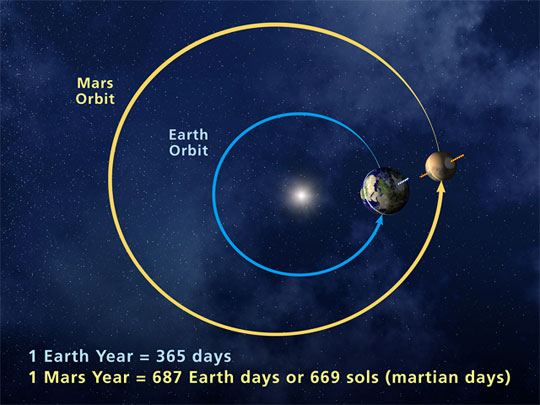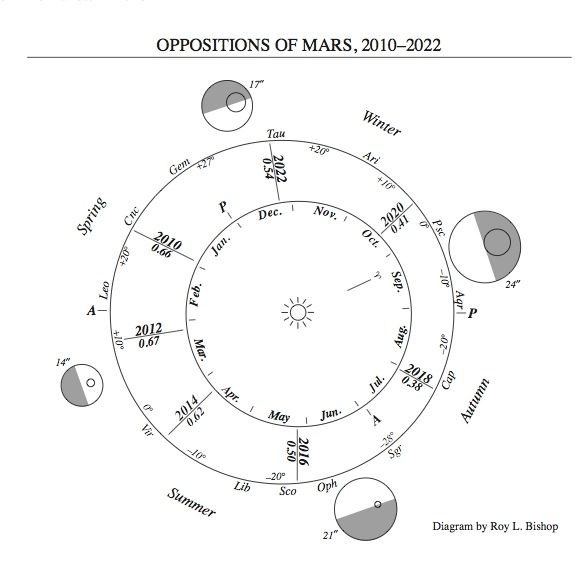
Artist’s illustration of the orbits of Earth and Mars, via NASA.
Mars comes closest to Earth every other year, around the time of its opposition. There’s an opposition coming up on July 27, 2018, and – at this very favorable opposition – Mars will also be at its brightest since 2003, when Mars made its closest approach to Earth in almost 60,000 years. Mars will be closest to us several days after opposition, with Mars coming to within 35.78 million miles (57.59 million km) of Earth on July 31, 2018.
Oppositions of Mars are far from equal. That’s because Mars’ eccentric (oblong) orbit carries this world about 26 million miles (43 million km) closer to the sun at perihelion (nearest point to the sun in its orbit) than when Mars swings out to aphelion (farthest point from the sun).
Oppositions that closely coincide with Mars at perihelion are much brighter and much more spectacular than distant oppositions that coincide with Mars swinging out to aphelion. That makes sense. When we pass between Mars and the sun – and Mars is closest in its orbit to the sun – then Mars is closest to us.
Nearly 60,000 years ago – on September 24, 57,617 B.C. – when Mars was only 34.62 million miles (55.72 million km) distant. That historic close opposition is still the closest Mars has come to Earth, although the opposition of Mars on August 28, 2003 – which brought Mars to 34.65 million miles (55.76 million km) of Earth – was Mars’ closest approach since the Stone Age. This record won’t be broken again until August 29, 2287. More about that date below.
In contrast, the very distant opposition of March 3, 2012, placed Mars at 62.62 million miles (100.78 million km) away.
So you see why the upcoming opposition – 35.78 million miles (57.59 million km) – is cause for excitement!

This diagram by Roy L. Bishop shows you the separation between Mars and Earth at recent oppositions. The separation of the 2 planets is expressed in Astronomical Units, or AU (one AU equals one Earth-sun distance) and is indicated beside each of the connecting lines at the various oppositions. Copyright Royal Astronomical Society of Canada. Used with permission. Visit the RASC estore to purchase the Observers Handbook, a necessary tool for all skywatchers. Read more about this image.
Close (or distant) oppositions of Mars recur in periods of 15 to 17 years. Note that we’re now 15 years past the historically close encounter on August 28, 2003.
Mars’ next extra-close opposition will be September 15, 2035, though – like the 2018 opposition – it won’t be as quite close as the opposition of August, 2003.
Very similar Martian oppositions take place every 79 years (15 + 17 + 15 + 17 + 15 = 79). These 79-year cycles repeat with only a delay of 2 to 5 calendar days. The super-close opposition of Mars in the year 2082 will fall on September 1, 2082. But once again, Earth and Mars won’t come as close as they did in August 2003.
There is a more exact cycle of 284 years (79 + 79 + 79 + 15 + 17 + 15 = 284). The Martian opposition that comes 284 years after August 28, 2003 will fall on August 29, 2287. This time around, Mars will come closer to Earth than it did during its close encounter in August 2003.
Because the Martian orbit is getting more eccentric (oblong), the closest oppositions will actually come closer to Earth, and the farthest oppositions will actually become more distant. The computational wizard Jean Meeus figures that from the years 0 to 3000, Mars will come closest to Earth on September 8, 2729 (55.65 million kilometers) and farthest away on March 6, 2832 (101.50 million kilometers).
Want to know more about close and far Martian oppositions? Click here.
While the time is at hand, enjoy the close appearance of Mars in Earth’s sky during July and August of 2018.
So put Mars viewing on your calendar for 2018. You won’t see Mars this size again until 2035. Illustration via nasa.tumblr.com.
Bottom line: Oppositions of Mars are far from equal. This post explains why Mars has near and far oppositions and shows why the 2018 opposition is a particularly good one.
from EarthSky https://ift.tt/2twixdw

Artist’s illustration of the orbits of Earth and Mars, via NASA.
Mars comes closest to Earth every other year, around the time of its opposition. There’s an opposition coming up on July 27, 2018, and – at this very favorable opposition – Mars will also be at its brightest since 2003, when Mars made its closest approach to Earth in almost 60,000 years. Mars will be closest to us several days after opposition, with Mars coming to within 35.78 million miles (57.59 million km) of Earth on July 31, 2018.
Oppositions of Mars are far from equal. That’s because Mars’ eccentric (oblong) orbit carries this world about 26 million miles (43 million km) closer to the sun at perihelion (nearest point to the sun in its orbit) than when Mars swings out to aphelion (farthest point from the sun).
Oppositions that closely coincide with Mars at perihelion are much brighter and much more spectacular than distant oppositions that coincide with Mars swinging out to aphelion. That makes sense. When we pass between Mars and the sun – and Mars is closest in its orbit to the sun – then Mars is closest to us.
Nearly 60,000 years ago – on September 24, 57,617 B.C. – when Mars was only 34.62 million miles (55.72 million km) distant. That historic close opposition is still the closest Mars has come to Earth, although the opposition of Mars on August 28, 2003 – which brought Mars to 34.65 million miles (55.76 million km) of Earth – was Mars’ closest approach since the Stone Age. This record won’t be broken again until August 29, 2287. More about that date below.
In contrast, the very distant opposition of March 3, 2012, placed Mars at 62.62 million miles (100.78 million km) away.
So you see why the upcoming opposition – 35.78 million miles (57.59 million km) – is cause for excitement!

This diagram by Roy L. Bishop shows you the separation between Mars and Earth at recent oppositions. The separation of the 2 planets is expressed in Astronomical Units, or AU (one AU equals one Earth-sun distance) and is indicated beside each of the connecting lines at the various oppositions. Copyright Royal Astronomical Society of Canada. Used with permission. Visit the RASC estore to purchase the Observers Handbook, a necessary tool for all skywatchers. Read more about this image.
Close (or distant) oppositions of Mars recur in periods of 15 to 17 years. Note that we’re now 15 years past the historically close encounter on August 28, 2003.
Mars’ next extra-close opposition will be September 15, 2035, though – like the 2018 opposition – it won’t be as quite close as the opposition of August, 2003.
Very similar Martian oppositions take place every 79 years (15 + 17 + 15 + 17 + 15 = 79). These 79-year cycles repeat with only a delay of 2 to 5 calendar days. The super-close opposition of Mars in the year 2082 will fall on September 1, 2082. But once again, Earth and Mars won’t come as close as they did in August 2003.
There is a more exact cycle of 284 years (79 + 79 + 79 + 15 + 17 + 15 = 284). The Martian opposition that comes 284 years after August 28, 2003 will fall on August 29, 2287. This time around, Mars will come closer to Earth than it did during its close encounter in August 2003.
Because the Martian orbit is getting more eccentric (oblong), the closest oppositions will actually come closer to Earth, and the farthest oppositions will actually become more distant. The computational wizard Jean Meeus figures that from the years 0 to 3000, Mars will come closest to Earth on September 8, 2729 (55.65 million kilometers) and farthest away on March 6, 2832 (101.50 million kilometers).
Want to know more about close and far Martian oppositions? Click here.
While the time is at hand, enjoy the close appearance of Mars in Earth’s sky during July and August of 2018.
So put Mars viewing on your calendar for 2018. You won’t see Mars this size again until 2035. Illustration via nasa.tumblr.com.
Bottom line: Oppositions of Mars are far from equal. This post explains why Mars has near and far oppositions and shows why the 2018 opposition is a particularly good one.
from EarthSky https://ift.tt/2twixdw

Aucun commentaire:
Enregistrer un commentaire